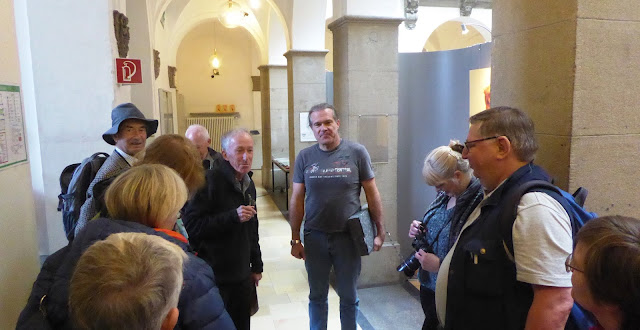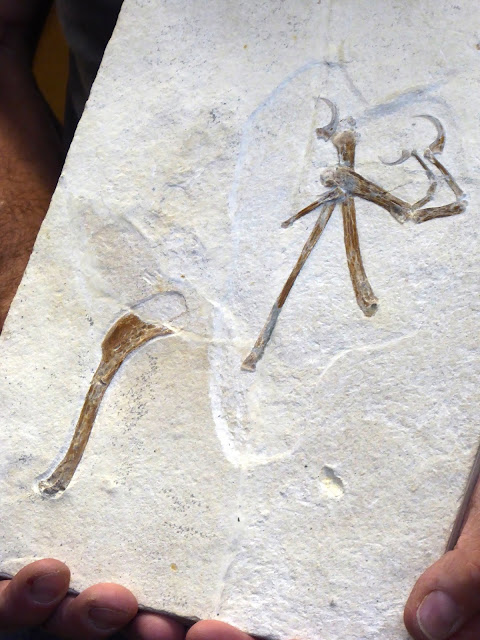
 A relaxed morning as it was only a couple of hour's drive to the airport, north of the city. The route took us through more attractive southern German countryside, with yet more half timbered houses and May bushes, before linking into the autobahn.
A relaxed morning as it was only a couple of hour's drive to the airport, north of the city. The route took us through more attractive southern German countryside, with yet more half timbered houses and May bushes, before linking into the autobahn.We checked into the hotel and ate our lunch, then spent most of the afternoon at the airport where John Nudds our leader had sensibly suggested meeting up at the Airbrau biergarten between the two terminals! Picked up cars, and drove back to the hotel where we found they had mistakenly ordered our dinner in for 8.30pm instead of 7.30 but fortunately we were able to swap times for the meeting room too and John gave us a fascinating briefing on what we would be doing during the week, including a complete run down on all the Archaeopteryx - both those we would, and those we wouldn't - see.
Archaeopteryx
In 1861, just after Darwin published his "Origin of Species", the first of these fossils was found and it seemed as though it provided the missing link between dinosaurs and birds.#1 A feather, and the London specimen
 This was found in August 1861 in 150 Ma old Upper Jurassic rocks. Previously the oldest known feather was from the Swiss Oligocene (30 Ma). Its asymmetry showed that it was aerodynamic but these early birds - Urvogel - were generally thought to be gliders rather than fliers.
This was found in August 1861 in 150 Ma old Upper Jurassic rocks. Previously the oldest known feather was from the Swiss Oligocene (30 Ma). Its asymmetry showed that it was aerodynamic but these early birds - Urvogel - were generally thought to be gliders rather than fliers.The London specimen was found just a few weeks later: it was birdlike but also had a dinosaur-like, long, bony tail.
It was described by von Meyer and initially he thought the skeleton would need another name but after argument between Meyer, Haberlein, and Richard Owen, it was agreed that the name of the feather could also apply to the skeleton.
#2 The Berlin specimen
This was found in Eichstätt in 1876. It has a complete skull and a three-fingered hand with external claws, perhaps for climbing vegetation. It was owned by Haberlein Jnr.
#3 Found in 1956, Maxberg
This disarticulated skeleton of a decayed bird was found by Edward Opitsch and has now been lost. In 1974 loan was refused and it was hidden permanently, in Pappenheim. Possibly lost, or stolen, or even buried with Opitsch!
#4 The Haarlem specimen
This is fragmentary - hind limbs, fingers with nice hand claws, wings. It was found in 1855 but thought originally to be a pterosaur and not described until later. Feathers on it were recognised in 1970. Oliver Rauhut, whom we met in Munich, shudied #4 and decided it was not an archaeopteryx but an avian dinosaur Ostromea crassipes. This is currently under discussion.
#5 Eichstätt
A small specimen, found in 1951 by Meyer, the head of the Willibaldsburg college as it was then, now the temporarily closed Jura Museum
#6 Solnhofen
The biggest but not so well prepped. Found by Herr Burgomeister Muller in 1988 and now the centrepiece of the museum where we will see it on Wednesday
#7 The Munich specimen
This was found in 1992 and worth DM 2 000 000. Housed in the Bavarian State Museum but may be on loan to Solnhofen.
#8 The Phantom
Found in the 1990s and bought Raymond Albersdorfer for a high price when he was putting a display together. John Nudds and Cindy Howells described it a s a new species.
#9 The "chicken wing"
Found in 2004, and has good 3D preservation of bones
#10 The Wyoming specimen
Found in 2005 and in a private collection. Worth €1,5M. This shows a foot which is evidence that it was not fully perching.
#11
Belongs to the same owner as #10 and has beautiful feather impressions.
#12 Dinosauria
We will see this on Saturday
#13
The newest specimen may now have been found
 John explained the stratigraphy and palaeogeography of the area - islands, lagoons and shallow seas. There's a suggestion that the urvogel may have speciated as they moved from one island to another because of variations in e.g. vegetation, in the same way that Darwin's Galapagos finches did.
John explained the stratigraphy and palaeogeography of the area - islands, lagoons and shallow seas. There's a suggestion that the urvogel may have speciated as they moved from one island to another because of variations in e.g. vegetation, in the same way that Darwin's Galapagos finches did.
Oh - and we did eventually get our dinners!
A morning in Munich
 |
| The Palaeontological Museum in Munich. This used to be the college of Arts and Crafts |
 |
| 25 tickets takes a long time! |
Bravely, John organised us to drive in convoy into the middle of Munich where we (amazingly) were still all together when we parked in a Parkhaus and then walked through the Viktualienmarkt to Marienplatz. Once there all 25 of us more or less took over the ticket machine while we all bought our tickets (couldn't get 25 in one transaction) and then caught the U-bahn to Konigsplatz near the Palaeontological Museum.
We had an appointment here to meet Dr Oliver Rauhut who divided us into two groups, one to visit the stores while the other explored the galleries.
 |
| Introduction to the museum by the curator, Dr Oliver Rauhut |
 |
| Triceratops |
 |
| Pterosaur soaring above a Giant Elk |
 |
| And a side view |
 |
| Plant fossils |
 |
| Notebook page with Oppel's drawing of the London specimen of Archaeopteryx lithographica. This was described by Richard Owen who concluded it was a bird, contrary to the original description |
 |
| Cuttlefish |
 |
| Oliver Rauhut showing us the counterpart of the original feather - Archaeopteryx No 1 |
 |
| The feather counterpart |
 |
| Composagnathus "lizard jaw" with meal remains in its stomach |
This is not an arachaeopteryx but slightly derived from it. The fossil comprises the upper wing, ulnar and radius etc. The second digit of the hand is slightly more robust than Archaeopterys but has smaller sheaths and claws. Later in the week we saw a Bavarian TV crew filming Oliver Rauhut at the quarry where it was found.
 |
| Alcmonavis, from the Mornsheim Formation. Paper published on 14/5/19 |
After a cafe break some walked and some caught taxis, back to the Marienplatz where we were meeting up to travel on to Eichstätt.


No comments:
Post a Comment